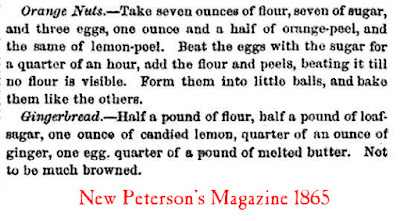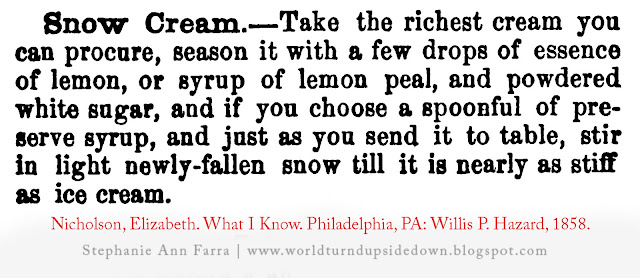***Humble plea from the web mistress: This time period is my favorite time period to cook from. It's also the time period I have the most recipes for. It's also the time period that gets absolutely no readers. So if you could like, share on facebook, cook and let people know how much you like reading about and cooking recipes from the time period, I would be very appreciative.***
I was originally going to bake the peanut cookies from the Royal Baking Powder Company's Best War Time Recipes (1917) but ended up finding a fun article from 1914 in The Women's Magazine that gave ideas for a children's Christmas Party. It declared "Every child likes peanut-butter cookies," and how could I argue with that?
The article also described some Children's Christmas game ideas: Pin the hat on Santa, a similar game called "The Christmas Candle" where the kids would be blindfolded, spun around and would try to blow out a candle on a ledge in front of them in 6 blows. Another game had two children see who could throw more pieces of popcorn into a fake "stocking," and win a small prize tied into the toe of the stocking.
The article especially intrigued me because it was published in January, not December. Some people were still celebrating until January 5th, or the "12 Days of Christmas." In the 1700s, New Year's was the time of feastivities and Christmas was more of a solemn holiday. By the early 1900s, Christmas had its own festivities and traditions. I think this is a wonderful concept because I can't always see everyone on Christmas but 12 days is probably enough to meet up with everyone.. :) I was also entertained at the suggestion of ice cream in January, when everyone had the ice and temperatures to make it.
The Women's Magazine also included the darling gift tags, which I've attached at the bottom in case anyone still has a few gifts they are wrapping and the recipe from Best War Time Recipes if anyone would like to try it. I might make those in the future to see how good the ration recipe compares to a recipe printed on the eve of war.
The recipe was in paragraph form though and I thought I would break it down for beginning cooks.
Ingredients:
- 2 Cups Sugar
- 1 Cup Butter (2 Sticks)
- 2 Eggs
- 1 Cup Peanut Butter
- 1 tsp Vanilla Extract
- 2 tsp Lemon Extract
- 1 tsp Salt
- 3 tsp Baking Powder
- 5 Cups Flour
- 1 Cup Peanuts, chopped
- 1/4 Cup Boiling water
- Icing [Here's a basic Icing Recipe.]
Instructions:
Preheat the oven to 375 degrees. In a large size bowl, cream the butter, sugar and peanut butter and boiling water. Let cool (so you don't cook the egg) add the extracts and salt. In a separate bowl, sift the flour and baking powder. Mix flour mixture into liquid mixture until it forms a firm dough. Knead for a few minutes with your hands until it is well combined. Roll 1 inch balls out of the dough and place on a cookie sheet. Bake for 9-11 minutes. Once removed from the oven flatten them down with a fork. Remove from cookie sheet to a cooling rack. Once cooled, ice and top with chopped peanuts.
The cookies do not spread in the oven at all so don't worry too much about crowding them. If you want spoon drop the cookies onto the sheet, that would work too.
I was originally going to bake the peanut cookies from the Royal Baking Powder Company's Best War Time Recipes (1917) but ended up finding a fun article from 1914 in The Women's Magazine that gave ideas for a children's Christmas Party. It declared "Every child likes peanut-butter cookies," and how could I argue with that?
The article also described some Children's Christmas game ideas: Pin the hat on Santa, a similar game called "The Christmas Candle" where the kids would be blindfolded, spun around and would try to blow out a candle on a ledge in front of them in 6 blows. Another game had two children see who could throw more pieces of popcorn into a fake "stocking," and win a small prize tied into the toe of the stocking.
The article especially intrigued me because it was published in January, not December. Some people were still celebrating until January 5th, or the "12 Days of Christmas." In the 1700s, New Year's was the time of feastivities and Christmas was more of a solemn holiday. By the early 1900s, Christmas had its own festivities and traditions. I think this is a wonderful concept because I can't always see everyone on Christmas but 12 days is probably enough to meet up with everyone.. :) I was also entertained at the suggestion of ice cream in January, when everyone had the ice and temperatures to make it.
The Women's Magazine also included the darling gift tags, which I've attached at the bottom in case anyone still has a few gifts they are wrapping and the recipe from Best War Time Recipes if anyone would like to try it. I might make those in the future to see how good the ration recipe compares to a recipe printed on the eve of war.
The recipe was in paragraph form though and I thought I would break it down for beginning cooks.
WWI Era Peanut Butter Cookies
Ingredients:
- 2 Cups Sugar
- 1 Cup Butter (2 Sticks)
- 2 Eggs
- 1 Cup Peanut Butter
- 1 tsp Vanilla Extract
- 2 tsp Lemon Extract
- 1 tsp Salt
- 3 tsp Baking Powder
- 5 Cups Flour
- 1 Cup Peanuts, chopped
- 1/4 Cup Boiling water
- Icing [Here's a basic Icing Recipe.]
Instructions:
Preheat the oven to 375 degrees. In a large size bowl, cream the butter, sugar and peanut butter and boiling water. Let cool (so you don't cook the egg) add the extracts and salt. In a separate bowl, sift the flour and baking powder. Mix flour mixture into liquid mixture until it forms a firm dough. Knead for a few minutes with your hands until it is well combined. Roll 1 inch balls out of the dough and place on a cookie sheet. Bake for 9-11 minutes. Once removed from the oven flatten them down with a fork. Remove from cookie sheet to a cooling rack. Once cooled, ice and top with chopped peanuts.
The cookies do not spread in the oven at all so don't worry too much about crowding them. If you want spoon drop the cookies onto the sheet, that would work too.








































